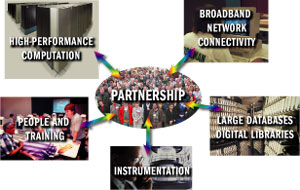|
 n important new concept is emerging-—that of cyberinfrastructure, a term coined by Ruzena Bajscy, NSF associate director for Computer and Information Science and Engineering. Cyberinfrastructure integrates distributed ("Grid") computing, high-speed communications, and information management capabilities as well as access to remote instruments and visualization devices into a single, coherent entity. The cyberinfrastructure defines the foreground of the computational landscape, identifying both its critical components and their interrelationships. It is key to the advancement of science and engineering in the new millennium, where new results increasingly require the marriage of such disciplinary fields as biology, chemistry, and environmental sciences with the enabling technologies of computer science. n important new concept is emerging-—that of cyberinfrastructure, a term coined by Ruzena Bajscy, NSF associate director for Computer and Information Science and Engineering. Cyberinfrastructure integrates distributed ("Grid") computing, high-speed communications, and information management capabilities as well as access to remote instruments and visualization devices into a single, coherent entity. The cyberinfrastructure defines the foreground of the computational landscape, identifying both its critical components and their interrelationships. It is key to the advancement of science and engineering in the new millennium, where new results increasingly require the marriage of such disciplinary fields as biology, chemistry, and environmental sciences with the enabling technologies of computer science.
 |
The Cyberinfrastructure
All the components depend upon the massed expertise of hundreds of people in long-term, team efforts |
The cyberinfrastructure is enabling scientific and engineering discoveries at an unprecedented scale. This is amply evident in such efforts as the Grid Physics Network (GriPhyN), the Alliance for Cellular Signaling, and the Joint Center for Structural Genomics, all featured recently in these pages. These projects unite widely distributed resources, from telescopes to genomic data bases to synchrotron beamlines, and their success will depend heavily on the way in which that unity is expressed as the scale of each project grows.
Putting the Infrastructure into Cyberinfrastructure
We hear a lot about the impact on science and engineering of cyberinfrastructure hardware resources (computers, storage, instruments, networks) or software tools and interfaces. Less heard, perhaps, is a discussion of the element most critical to the success of the cyberinfrastructure-–its human infrastructure.
The cyberinfrastructure’s human infrastructure is a synergistic collaboration of hundreds of researchers, programmers, software developers, tool builders, and others who understand the difficulties of developing applications and software for a complex, distributed, and dynamic environment. These people are able to work together to develop the software infrastructure, tools, and applications of the cyberinfrastructure. They provide the critical human network required to prototype, integrate, harden, and nurture ideas from concept to maturity.
The personal networks, knowledge, and relationships of the human infrastructure take a long time to build and are critical to the usability of the resources. In particular, the advances we now enjoy in science and engineering are the fruit of the many years of cooperation in the national effort to unite computational and computer sciences.
The Role of PACI
The Partnerships for Advanced Computational Infrastructure (PACI) program has provided national leadership for building the cyberinfrastructure. Indeed, it is hard to imagine the development of so large an endeavor without a program like PACI. The scale required for the integration of the cyberinfrastructure components would not be possible without large-scale and innovative hardware and software resources. The synergy required for today’s advances in science and engineering would not be possible without the long-term investment in people that has been made to develop the expertise, domain knowledge, and relationships required.
I have been fortunate to be part of this human infrastructure, as a researcher and PACI partner and now as director of NPACI and SDSC. Participating in the MCell and Telescience alpha projects, for example, has given me first-hand experience of the importance of synergistic collaboration within the human infrastructure. In both projects, disciplinary needs have driven the development of leading-edge software, and the software has helped the disciplinary scientists to achieve important results.
The PACI program encompasses the hardware and software resources of the cyberinfrastructure as well as its human resources. NPACI, for example, is at the forefront of data-intensive computing, with projects that span the universe (in the Digital Sky) and that expect to persist indefinitely into the future (as with the archives of the National Archives and Records Administration). Our expertise in bioinformatics and computational biology has enabled us to propose, build, and enhance world-class resources for those disciplines and to use that experience and expertise to make similar efforts in geoinformatics and remote-sensing technology. As the articles in this and other issues of EnVision demonstrate, NPACI focuses and enlarges the effort of the many leaders in the various fields, building partnerships that work.
As you read the articles in EnVision, take a moment to reflect on the people who make the science happen--the human infrastructure of the cyberinfrastructure. Of all the components in the cyberinfrastructure, the human component is particularly critical to its success of the whole and it is a component of which we at NPACI can be justly proud.
|
By Fran Berman
NPACI and SDSC Director |


 Skip to navigation
Skip to navigation
